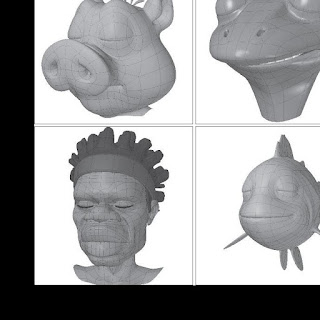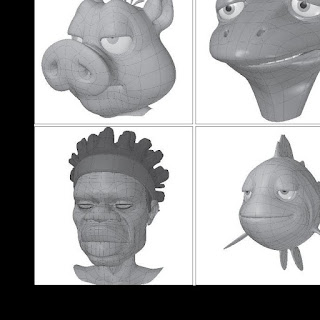The eye morphs consist of the movement and concept of the eye covers and eye-brows.
Before we shift on to the morphs, let us take a look at the platform designs for
the figures used in the following illustrations.
Before we shift on to the morphs, let us take a look at the platform designs for
the figures used in the following illustrations.
 | ||||
| Figure 2.2-1. Base models. |
I’ve involved a variety of figures for the illustrations. Each personality has slightly
different specifications, so you can see the variations for each transform. For the
eye morphs I’ve involved Taylor* (top-right) to demonstrate illustrations of the eye
morphs for a personality without any eye-brows.
When you are developing your platform personality, try to create its concept as
neutral as possible. Often a concept for a personality reveals it cheerful or showing
some kind of feelings. If you design feelings into the platform personality it makes
creating and animating the face functions much more challenging, so design it in a
neutral concept, enabling the morphs and animated to do the job of expressing
emotion.
different specifications, so you can see the variations for each transform. For the
eye morphs I’ve involved Taylor* (top-right) to demonstrate illustrations of the eye
morphs for a personality without any eye-brows.
When you are developing your platform personality, try to create its concept as
neutral as possible. Often a concept for a personality reveals it cheerful or showing
some kind of feelings. If you design feelings into the platform personality it makes
creating and animating the face functions much more challenging, so design it in a
neutral concept, enabling the morphs and animated to do the job of expressing
emotion.
Blink
 |
| Figure 2.2-2. Eye.Blink. |
When we flicker, our higher lid tends to journey further than our reduced lid, creating
a conference of the eye covers about two-thirds of the way down the eye. The higher lid
also tends to be a little bit bulkier than the reduced lid, so it overlaps the reduced eyelid
a little bit. This also allows to determine the form of the be a part of between covers.
Blink should only impact the eye lid geometry.
This transform is used for flashing, getting to sleep, sensation drowsy, or anywhere else a
character ends his sight.
a conference of the eye covers about two-thirds of the way down the eye. The higher lid
also tends to be a little bit bulkier than the reduced lid, so it overlaps the reduced eyelid
a little bit. This also allows to determine the form of the be a part of between covers.
Blink should only impact the eye lid geometry.
This transform is used for flashing, getting to sleep, sensation drowsy, or anywhere else a
character ends his sight.
Squint
 |
| Figure 2.2-3. Eye.Squint. |
The scrunch up your sight is very just like the flicker, except the eye covers fulfill in the center of
the eye.
Squint should only impact the eye lid geometry.
Squint is used to express mistrust, responding to shiny mild, or trying to see
something far away. It can also be used for flashing when a character’s sight are
looking up.
the eye.
Squint should only impact the eye lid geometry.
Squint is used to express mistrust, responding to shiny mild, or trying to see
something far away. It can also be used for flashing when a character’s sight are
looking up.
Lid Up
 |
| Figure 2.2-4. Eye.Lid_Up. |
This is just the higher eye lid aspect of Squint.
Lid_Up should only impact the higher eye lid geometry.
The higher eye lid is used to express condescension or can be used when a
character is looking down. It can also improve an upset concept when used
with the Grimace transform.
Lid_Up should only impact the higher eye lid geometry.
The higher eye lid is used to express condescension or can be used when a
character is looking down. It can also improve an upset concept when used
with the Grimace transform.
Lid Low
 |
| Figure 2.2-5. Eye.Lid_Low. |
This is just the reduced eye lid aspect of Squint.
Lid_Low should only impact the reduced eye lid geometry.
The reduced eye lid can be used to express unhappiness or can be used when a
character is looking up. Just one reduced eye lid can have a anxious tic to indicate the beginning of
a anxious malfunction.
Lid_Low should only impact the reduced eye lid geometry.
The reduced eye lid can be used to express unhappiness or can be used when a
character is looking up. Just one reduced eye lid can have a anxious tic to indicate the beginning of
a anxious malfunction.
Frown
 |
| Figure 2.2-6. Eye.Frown. |
The frown is the downwards activity of the eye-brows. Often some of the
upper eye lid geometry is applied to some stage in animated figures to
enhance or embellish the concept. For most figures, take health care not to
move the top rated of the eye lid or you may need an additional transform for
blinking.
The exemption to this is when a personality does not have eye-brows (as in the
top-right example); then it may be necessary to consist of the eye covers to produce
the frown. In this situation you need to decrease the Grimace transform when flashing, but
that’s excellent because decreasing the Grimace transform to flicker does not adversely
affect the concept.
Frown should mainly impact the brow geometry, using the top and middle
areas of the eye lid to improve the concept if necessary.
The frown mainly provides rage, although it can also express misunderstandings or
surprise when used asymmetrically.
upper eye lid geometry is applied to some stage in animated figures to
enhance or embellish the concept. For most figures, take health care not to
move the top rated of the eye lid or you may need an additional transform for
blinking.
The exemption to this is when a personality does not have eye-brows (as in the
top-right example); then it may be necessary to consist of the eye covers to produce
the frown. In this situation you need to decrease the Grimace transform when flashing, but
that’s excellent because decreasing the Grimace transform to flicker does not adversely
affect the concept.
Frown should mainly impact the brow geometry, using the top and middle
areas of the eye lid to improve the concept if necessary.
The frown mainly provides rage, although it can also express misunderstandings or
surprise when used asymmetrically.
Sad
 |
| Figure 2.2-7. Eye.Sad. |
The Sad transform is the upwards activity of the within of the eye-brows. To exaggerate
the concept you can also shift the outside of the eye-brows down a
little. As with the Grimace, be cautious when using the eye lid geometry to enhance
the concept.
Sad should mainly impact the brow geometry, using the top and middle
areas of the eye lid to improve the concept if necessary.
The Sad transform can express unhappiness, asking, or worry.
the concept you can also shift the outside of the eye-brows down a
little. As with the Grimace, be cautious when using the eye lid geometry to enhance
the concept.
Sad should mainly impact the brow geometry, using the top and middle
areas of the eye lid to improve the concept if necessary.
The Sad transform can express unhappiness, asking, or worry.
High
 |
| Figure 2.2-8. Eye.High. |
The Great transform is the upwards activity of the whole brow.
High should only impact the brow geometry.
The Great transform can express worry or shock, or misunderstandings when used asymmetrically.
It can also be used to highlight a factor.
High should only impact the brow geometry.
The Great transform can express worry or shock, or misunderstandings when used asymmetrically.
It can also be used to highlight a factor.
Lift
 |
| Figure 2.2-9. Eye.Lift. |
The Raise transform is the upwards activity of the outside of the eye-brows.
Lift should only impact the brow geometry.
The Raise transform can express disappointment or shock, or misunderstandings when used
asymmetrically.
Lift should only impact the brow geometry.
The Raise transform can express disappointment or shock, or misunderstandings when used
asymmetrically.
Dilate
 |
| Figure 2.2-10. Eye.Dilate. |
Dilate is the dilating of the student. If you have designed the student little, then you need
to create it larger; if the student is huge, then you should create it little. When the
eyeball is a individual area, as we have in Morfi (see Amount 1: Modelling & Texturing)
and Hamish, create sure you modify the geometry once you have scaly the
pupil to maintain the same curve of the eye itself as the platform. Pupil dilation is a
subconscious respond to the quantity of mild reaching the eye itself. The pupil
becomes bigger in reduced mild and little in shiny mild. It’s usually a excellent idea
to standard to somewhere in between the two extreme conditions.
Dilate should only impact the student and eye of the eye itself.
As well as displaying the stage of mild, offsetting the quantity of dilation for
each student can express madness.
to create it larger; if the student is huge, then you should create it little. When the
eyeball is a individual area, as we have in Morfi (see Amount 1: Modelling & Texturing)
and Hamish, create sure you modify the geometry once you have scaly the
pupil to maintain the same curve of the eye itself as the platform. Pupil dilation is a
subconscious respond to the quantity of mild reaching the eye itself. The pupil
becomes bigger in reduced mild and little in shiny mild. It’s usually a excellent idea
to standard to somewhere in between the two extreme conditions.
Dilate should only impact the student and eye of the eye itself.
As well as displaying the stage of mild, offsetting the quantity of dilation for
each student can express madness.


Post a Comment